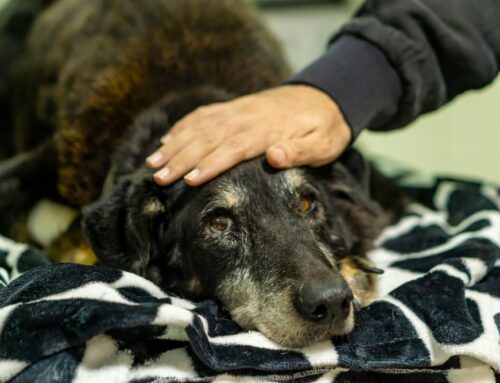Caring for Pets with Osteoarthritis: A Comprehensive Guide
Living with a pet experiencing osteoarthritis (OA) can be a challenging journey, both for your pet and for you as a devoted pet owner. At Bayview Animal Hospital in St. Petersburg, Florida, we understand the emotional turmoil and practical concerns you might be facing as your pet navigates this common condition. It’s heart-wrenching to see your pet limping or hesitating to jump or climb the stairs, and we’re here to offer the support, information, and care you need to manage this condition effectively.
Understanding Osteoarthritis in Pets
Osteoarthritis is a degenerative joint disease characterized by the gradual breakdown of cartilage within the joints. This breakdown leads to bone-on-bone friction, causing pain and inflammation. It’s important to note that OA isn’t solely an “old pet” problem—pets of any age can be affected. While arthritis might sound like an intimidating term, learning about it can empower you to provide the best possible care for your pet.
Common Causes of Osteoarthritis
Several factors can contribute to the development of osteoarthritis in pets:
- Genetic Predisposition: Certain breeds, like German Shepherds, may inherit conditions such as hip dysplasia.
- Joint Injuries: Past injuries, including cruciate ligament tears, can lead to OA.
- Obesity: Excess weight puts additional strain on joints, accelerating cartilage wear and tear.
- Developmental Abnormalities: Conditions like elbow dysplasia affect joint health.
- Age-Related Wear: As pets age, cumulative wear on their joints can lead to OA.
The Importance of Recognizing Osteoarthritis
Your pet’s well-being is our priority, which is why recognizing and addressing osteoarthritis is crucial. OA can severely impact their quality of life, causing chronic pain that limits mobility and affects mood and behavior. By intervening early, we can help slow the progression of the disease and improve your pet’s comfort and happiness.
Symptoms and Signs of Osteoarthritis
Pets with osteoarthritis may exhibit a range of signs and symptoms. Understanding these can help you identify the condition early:
Common Signs:
- Limping or stiffness, particularly after periods of rest (AKC explains).
- Reluctance to jump, climb stairs, or play.
- Reduced range of motion.
- Changes in posture or gait.
- Irritability or aggression when touched near painful joints.
Subtle Signs:
- Withdrawal from social interaction.
- Altered sleeping patterns.
- Increased licking or grooming of affected areas.
- Muscle loss around affected joints.
Species-Specific Signs:
- Dogs: Panting excessively, difficulty rising, lagging behind on walks.
- Cats: Changes in grooming, litter box habits, and social behavior (iCatCare offers insight).
The Progression of Osteoarthritis
Understanding how osteoarthritis progresses can help you cater to your pet’s changing needs. Without treatment, OA can evolve from mild discomfort to advanced stages characterized by severe pain, significant joint damage, and muscle atrophy. Intermittent flare-ups might occur, heightening the need for a consistent management plan.
How We Diagnose Osteoarthritis
At Bayview Animal Hospital, our comprehensive approach to diagnosing OA includes:
- Physical Examination: Assessing gait, posture, and joint range of motion.
- Diagnostic Imaging: Utilizing X-rays to visualize joint changes. In complex cases, CT or MRI may be needed.
- Joint Fluid Analysis: Examining joint fluid to rule out infections or other inflammatory conditions.
Treatment Options for Osteoarthritis
Managing osteoarthritis often requires a multifaceted treatment plan, tailored to your pet’s specific needs:
- Weight Management: Achieving a healthy weight to reduce joint stress through specialized diets and exercise.
- Pain Management: Including NSAIDs, tramadol, gabapentin, and supplements like glucosamine and omega-3s.
- Joint Injections: Using corticosteroids and other therapies to provide relief.
- Physical Rehabilitation: Incorporating exercises, hydrotherapy, massage, and laser therapy (AKC details these).
- Surgery: As a last resort, procedures like joint replacement may be considered.
- Integrative Therapies: Options such as acupuncture and herbal remedies. For more in-depth information about rehabilitation, Canine Arthritis offers guidance.
Consequences of Untreated Osteoarthritis
If left untreated, osteoarthritis can lead to severe pain and mobility issues, muscle weakness, and secondary problems in other joints. This not only impacts your pet’s physical health but also their emotional well-being, making everyday activities challenging and diminishing their quality of life.
Supporting Your Pet’s Daily Life
Adapting daily routines to accommodate your pet’s comfort and mobility can make a significant difference:
- Home Modifications: Consider ramps, non-slip flooring, and orthopedic beds.
- Exercise Adjustments: Focus on low-impact activities, frequent short walks, and warm-up/cool-down routines (Canine Arthritis Resources suggests).
- Grooming Adjustments: Gentle brushing and massage can alleviate tension (National Cat Groomers provides tips).
- Emotional Support: Create a calm environment and spend quality time together.
Current Trends and Research
Ongoing research continues to provide hope in the fight against osteoarthritis. Emerging therapies, such as regenerative medicine, gene therapy, and the role of diet and nutrition in joint health, are at the forefront. For additional insights, refer to the Mobility Matters Guide.
Preparing for Your Veterinary Visit
When visiting us for osteoarthritis concerns, bring:
- A list of medications and supplements.
- Videos of your pet experiencing difficulty.
- Relevant medical records.
- A stool sample. During your appointment, we encourage you to ask questions such as:
- “What are the best pain management options for my pet?”
- “How can I modify my home environment for comfort?”
- “What is the long-term prognosis?” For further reading on veterinary care for senior pets, see Zoetis Petcare’s recommendations.

Common FAQs
Can osteoarthritis be cured?
While OA cannot be cured, its symptoms can be managed effectively.
What is the best exercise for a dog with osteoarthritis?
Low-impact activities are ideal, such as walking and swimming (Zoetis Petcare provides details). Are there any side effects of long-term pain medication use?
Yes, NSAIDs and other medications can have side effects, necessitating regular vet monitoring.
Your Partner in Joint Health
At Bayview Animal Hospital, we are dedicated to helping you and your pet navigate the journey of osteoarthritis with care and compassion. We understand the emotional toll this condition can have, and we are here to provide both medical expertise and moral support. If you have any concerns or wish to discuss the best care plan for your pet, schedule an appointment with us today. Our team is here to support you and ensure your pet lives comfortably and happily. Visit our website or contact us for more information.







Leave A Comment